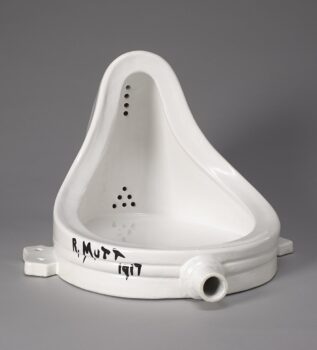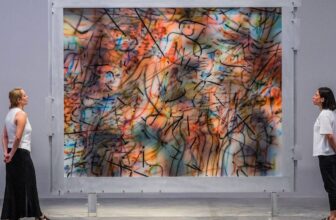Famous Marcel Duchamp Paintings and Artworks
In the dimly lit galleries of modern museums, amidst the riotous colors of Kandinsky and the twisted forms of Picasso, stands a urinal. It is not just any urinal, but “Fountain”, an ordinary porcelain object signed “R. Mutt” and dated 1917. It sits alone, unapologetic and bold. And behind this controversial piece was Marcel Duchamp, a French-American artist who didn’t just paint, he challenged the very essence of what art could be.
Duchamp was a provocateur, a thinker, and arguably the most radical artist of the 20th century. While he may not be known for producing hundreds of canvases like Monet or Van Gogh, his impact on contemporary art is nothing short of seismic. Through a relatively small body of work, Duchamp turned the art world upside down.
A Radical from Rouen
Marcel Duchamp was born on July 28, 1887, in Blainville-Crevon, near Rouen, France, into a family of artists. His early exposure to the arts came not only from school but also from his family, his siblings Raymond Duchamp-Villon and Jacques Villon were accomplished artists themselves.
In his youth, Duchamp was intrigued by Impressionism and Post-Impressionism, yet even then, he viewed the traditional modes of painting with a critical eye. This perspective would later evolve into a full-blown rebellion against the constraints of aesthetic beauty and craftsmanship.
The Evolution of Duchamp’s Artistic Vision
Early in his career, Duchamp experimented with different styles. One of his early masterpieces, “Nude Descending a Staircase, No. 2” (1912), combines elements of Cubism and Futurism, depicting motion through a fragmented, mechanized figure. The painting caused a scandal when exhibited at the 1913 Armory Show in New York, a sign that Duchamp was on the path to shaking the foundations of the art world.
But Duchamp wasn’t content to stay within the realm of painting. Around 1913, he began moving away from traditional methods and materials. He famously said:
“I was interested in ideas, not merely in visual products.”
It was this shift in focus that marked the birth of Conceptual Art, with Duchamp as its pioneer.
What Was Marcel Duchamp Known For?
Marcel Duchamp was known primarily for challenging the definition of art. He is most famous for inventing the concept of the “readymade”, an ordinary object presented as art simply because the artist chose it.
This idea was revolutionary. In Duchamp’s world, an industrially produced object could be elevated to the status of “art” through context, intention, and presentation. It was a bold slap in the face to centuries of academic tradition.
Key innovations Duchamp is known for include:
Readymades: Objects like “Fountain” (1917) and “Bicycle Wheel” (1913).
Anti-Art Philosophy: He rejected the traditional focus on technique and beauty.
Dada Movement: Though Duchamp rejected labels, he was a major influence in the Dada movement, which embraced absurdity and chaos as a reaction to World War I.
Conceptual Art: His ideas paved the way for artists like Joseph Beuys, John Cage, and Damien Hirst.
How Did Marcel Duchamp Make His Paintings?
Duchamp’s painting technique varied drastically depending on the period and the piece. Early on, his work was more traditional, employing oil paints on canvas. But even then, he was incorporating innovative ideas:
In “Nude Descending a Staircase”, he used Cubist fragmentation to depict motion over time, something rarely attempted in painting.
In “The Bride Stripped Bare by Her Bachelors, Even” (The Large Glass), Duchamp employed glass, lead wire, foil, and dust, rather than canvas or traditional materials.
Duchamp also experimented with optical devices. His work “Rotary Demisphere (Precision Optics)” was a kinetic sculpture designed to alter perception, blurring the line between painting, sculpture, and machine.
He was a thinker first, an artisan second. Most of Duchamp’s works weren’t about aesthetic pleasure; they were about challenging the viewer’s expectations.
Famous Marcel Duchamp Paintings and Artworks
While Duchamp’s output was limited in terms of quantity, many of his works are iconic. Here are some of the most famous:
1. Nude Descending a Staircase, No. 2 (1912)
This Cubo-Futurist masterpiece scandalized American audiences at the Armory Show in 1913. It depicted a figure in motion, abstracted into dynamic planes.
2. Fountain (1917)
The infamous urinal signed “R. Mutt” that changed art forever. Rejected by the art exhibition it was submitted to, “Fountain” remains one of the most significant works in art history.
3. The Bride Stripped Bare by Her Bachelors, Even (The Large Glass) (1915–1923)
A massive and enigmatic glass piece housed at the Philadelphia Museum of Art. It took Duchamp eight years to complete and remains one of his most ambitious conceptual works.
4. Bicycle Wheel (1913)
Often cited as the first readymade, Duchamp mounted a bicycle wheel on a wooden stool, not to be looked at as art, but “to watch it turn, like fire in a fireplace.”
5. L.H.O.O.Q. (1919)
A postcard reproduction of the Mona Lisa with a mustache drawn on and a pun in French. This piece irreverently critiques the reverence for traditional masterpieces.
6. Étant donnés (1946–1966)
This final work, completed in secrecy over 20 years, is a peep-hole diorama that shocks and seduces viewers with its voyeuristic mystery. It’s permanently installed in the Philadelphia Museum of Art.
What Art Style Is Marcel Duchamp Associated With?
Duchamp’s style defies categorization, but he is most commonly linked to:
Dada: An anti-art, anti-war movement that embraced absurdity and nonsense. Duchamp was central to Dada’s ideas, even if he resisted full affiliation.
Conceptual Art: He is widely regarded as the father of Conceptual Art, prioritizing the concept over aesthetics.
Surrealism: Duchamp was connected to Surrealist circles, particularly through his alter ego Rrose Sélavy, a female persona he used to sign some of his works.
His disdain for labels was consistent. He believed art was less about style and more about provocation.
What Materials Did Marcel Duchamp Use?
Duchamp famously said, “Art is either plagiarism or revolution.” In line with his revolutionary approach, he used a wide variety of materials:
Everyday Objects: Urinals, bottle racks, bicycle wheels, snow shovels.
Glass and Metal: As in “The Large Glass.”
Industrial Items: Readymades came from hardware stores and industrial catalogs.
Photographs and Prints: Used in works like “L.H.O.O.Q.”
Kinetic Elements: Spinning discs, motors, and optical illusions.
Duchamp broke all the rules, using whatever medium best suited his ideas, regardless of tradition.
How Many Paintings Does Marcel Duchamp Have?
Unlike prolific painters like Van Gogh or Picasso, Duchamp produced relatively few paintings, less than 20 significant painted works. After around 1918, he all but abandoned painting entirely, considering it a “retinal art” focused too much on pleasing the eye.
Instead, he focused on readymades, conceptual work, and later in life, the secretive construction of “Étant donnés.”
Despite the small volume, each piece has had enormous influence, and many are considered masterpieces of 20th-century art.
How Much Do Marcel Duchamp Paintings Cost?
Duchamp’s works are extremely rare and rarely come up for public auction, which makes valuations difficult. However:
In 2002, one of his early works, “Belle Haleine – Eau de Voilette”, sold for $2.7 million.
In 2009, “Fountain” (1917) replicas (approved by Duchamp in the 1960s) have sold for over $1.7 million.
Duchamp’s original artworks and readymades are mostly in museums, and their market value is essentially priceless.
Collectors and institutions that own Duchamp’s pieces consider them cultural treasures, more than mere commodities.
Where Are Marcel Duchamp’s Paintings Located?
Duchamp’s legacy is preserved in museums and collections across the globe. Key institutions that house his work include:
1. Philadelphia Museum of Art (USA)
The most important Duchamp collection in the world. It includes:
“The Large Glass”
“Étant donnés”
Dozens of readymades and archival materials
2. Museum of Modern Art (MoMA), New York
MoMA houses several Duchamp pieces and exhibits his influence on 20th-century art.
3. Tate Modern (London)
Holds Duchamp’s readymades and conceptual works.
4. Centre Pompidou (Paris)
Features works from Duchamp and the Dada movement.
5. National Gallery of Canada (Ottawa)
Owns works by Duchamp and documents his Canadian connections.
Most of his famous pieces are not in private hands but preserved in public collections, ensuring they continue to provoke, confuse, and inspire new generations.
Marcel Duchamp didn’t just create art; he redefined it.
While he may not have filled galleries with painted canvases, Duchamp’s ideas had a profound impact on every major art movement that followed: Pop Art, Minimalism, Conceptual Art, and even Digital Art.
By declaring that an ordinary object could be art, Duchamp freed artists from the tyranny of the brush, the pedestal, and even the museum itself.
In his words:
“I threw the bottle rack and the urinal into their faces as a challenge, and now they admire them for their aesthetic beauty.”
A century later, the art world is still reeling from that challenge, and perhaps that is Duchamp’s greatest masterpiece of all.




